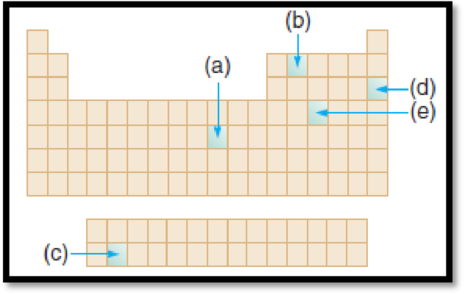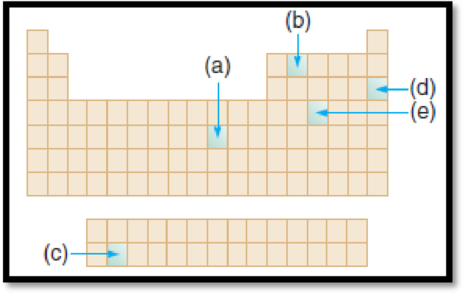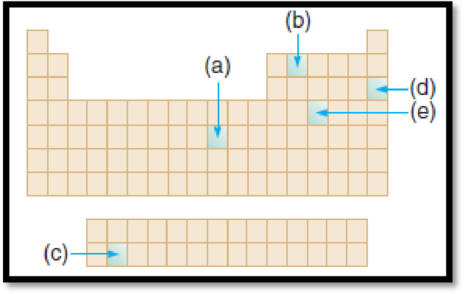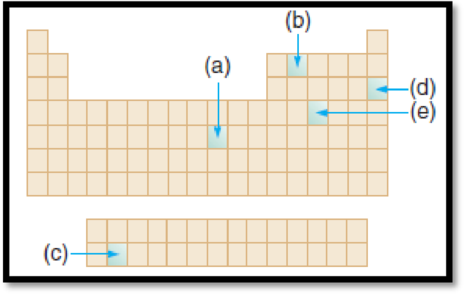
Connect 1-Semester Online Access for Principles of General, Organic & Biochemistry
2nd Edition
ISBN: 9780077633707
Author: Janice Smith
Publisher: Mcgraw-hill Higher Education (us)
expand_more
expand_more
format_list_bulleted
Question
Chapter 2, Problem 2.56AP
(a)
Interpretation Introduction
Interpretation:
The marked element (a) in the given figure have to be given.
The given diagram is,

Figure 1
(b)
Interpretation Introduction
Interpretation:
The marked element (b) in the given figure has to be given.
The given diagram is,

Figure 1
(c)
Interpretation Introduction
Interpretation:
The marked element (c) in the given figure has to be given.
The given diagram is,

Figure 1
(d)
Interpretation Introduction
Interpretation:
The marked element (d) in the given figure has to be given.
The given diagram is,

Figure 1
(e)
Interpretation Introduction
Interpretation:
The marked element (e) in the given figure has to be given.
The given diagram is,

Figure 1
Expert Solution & Answer
Want to see the full answer?
Check out a sample textbook solution
Students have asked these similar questions
[ 3rd ] Instructions: Kindly provide the complete and correct solutions. (There are some questions that needs to be based in a periodic table, kindly base it on the one I provided below) I won't like it if it is incomplete and incorrect.
To what group number does each element belong?(a) germanium(b) nitrogen(c) sulfur(d) carbon(e) boron
Be sure to answer all parts.
Identify the highlighted element in the periodic table and give its:
[1] element name and symbol;
[2] group number;
[3] period;
[4] classification (i.e., main group element, transition metal, or inner transition metal).
Element name, (symbol)
Group number
(select)
Period
Classification
(select)
47
raw
pe here to search
< Prev.
12
Chapter 2 Solutions
Connect 1-Semester Online Access for Principles of General, Organic & Biochemistry
Ch. 2.1 - Give the symbol for each element. a. calcium, a...Ch. 2.1 - Prob. 2.2PCh. 2.1 - Give the name corresponding to each element...Ch. 2.1 - Locate each element in the periodic table and...Ch. 2.1 - Classify each micronutrient in Figure 2.2 as a...Ch. 2.1 - Identify the elements used in each example of...Ch. 2.1 - Identify the elements in each chemical formula,...Ch. 2.1 - Prob. 2.8PCh. 2.2 - Prob. 2.9PCh. 2.2 - Prob. 2.10P
Ch. 2.2 - Prob. 2.11PCh. 2.2 - Prob. 2.12PCh. 2.2 - Prob. 2.13PCh. 2.3 - Prob. 2.14PCh. 2.3 - Prob. 2.15PCh. 2.3 - Prob. 2.16PCh. 2.3 - Prob. 2.17PCh. 2.3 - Prob. 2.18PCh. 2.4 - Prob. 2.19PCh. 2.4 - Give the period and group number for each element:...Ch. 2.4 - Prob. 2.21PCh. 2.4 - Prob. 2.22PCh. 2.5 - Prob. 2.23PCh. 2.6 - Prob. 2.24PCh. 2.6 - Prob. 2.25PCh. 2.6 - Prob. 2.26PCh. 2.7 - Identify the total number of electrons, the number...Ch. 2.7 - Prob. 2.28PCh. 2.7 - Prob. 2.29PCh. 2.8 - Which element in each pair has the larger atomic...Ch. 2.8 - Which element in each pair has the higher...Ch. 2.8 - Prob. 2.32PCh. 2 - Identify the elements used in each example of...Ch. 2 - Prob. 2.34UKCCh. 2 - Prob. 2.35UKCCh. 2 - Prob. 2.36UKCCh. 2 - Prob. 2.37UKCCh. 2 - Prob. 2.38UKCCh. 2 - Prob. 2.39UKCCh. 2 - Prob. 2.40UKCCh. 2 - Prob. 2.41UKCCh. 2 - Prob. 2.42UKCCh. 2 - Prob. 2.43UKCCh. 2 - Prob. 2.44UKCCh. 2 - Prob. 2.45APCh. 2 - Prob. 2.46APCh. 2 - Prob. 2.47APCh. 2 - Identify the elements in each chemical formula and...Ch. 2 - Prob. 2.49APCh. 2 - Prob. 2.50APCh. 2 - Prob. 2.51APCh. 2 - Prob. 2.52APCh. 2 - Prob. 2.53APCh. 2 - Prob. 2.54APCh. 2 - Prob. 2.55APCh. 2 - Prob. 2.56APCh. 2 - Prob. 2.57APCh. 2 - Prob. 2.58APCh. 2 - The most common isotope of oxygen has a mass...Ch. 2 - Prob. 2.60APCh. 2 - Prob. 2.61APCh. 2 - Prob. 2.62APCh. 2 - Prob. 2.63APCh. 2 - Prob. 2.64APCh. 2 - Prob. 2.65APCh. 2 - Prob. 2.66APCh. 2 - Prob. 2.67APCh. 2 - Prob. 2.68APCh. 2 - Prob. 2.69APCh. 2 - Prob. 2.70APCh. 2 - Prob. 2.71APCh. 2 - Prob. 2.72APCh. 2 - Prob. 2.73APCh. 2 - Prob. 2.74APCh. 2 - Prob. 2.75APCh. 2 - Prob. 2.76APCh. 2 - Prob. 2.77APCh. 2 - Prob. 2.78APCh. 2 - Prob. 2.79APCh. 2 - Prob. 2.80APCh. 2 - Prob. 2.81APCh. 2 - Prob. 2.82APCh. 2 - Prob. 2.83APCh. 2 - Arrange the elements in each group in order of...Ch. 2 - Prob. 2.85APCh. 2 - Prob. 2.86APCh. 2 - Answer the following questions about...Ch. 2 - Prob. 2.88APCh. 2 - Prob. 2.89APCh. 2 - (a) What is the chemical formula for...Ch. 2 - Prob. 2.91CPCh. 2 - Prob. 2.93BTCCh. 2 - Prob. 2.95BTC
Knowledge Booster
Learn more about
Need a deep-dive on the concept behind this application? Look no further. Learn more about this topic, chemistry and related others by exploring similar questions and additional content below.Similar questions
- Classify the following as metals, nonmetals, or metalloids: a.argon b.element 3 c.Ge d.boron e.Pmarrow_forward2.42 What is a period in the periodic table? From what does it derive its name?arrow_forward2.84 Early attempts to arrange the elements often focused on atomic weight. Mendeleev considered a number of properties in addition to atomic weight, so he realized that some elements seemed out of place when ordered by atomic weight. Using the modern periodic table, identify elements for which Mendeleev must have had to switch the order in order to get the correct sequence of elements.arrow_forward
- One of the best indications of a useful theory is that it raises more questions for further experimentation than it originally answered. Does this apply to Daltons atomic theory? Give examples.arrow_forward2.96 Use the web to look up the density of different forms of steel, such as stainless steel or magnetic steel, and discuss whether or not the differences in the densities follow what might he predicted by looking at the periodic properties of elements.arrow_forwardWhat is the name of the element in Group 4A and Period 5?arrow_forward
- Q2. This question is about the periodicity of the Period 3 elements. (a) State and explain the general trend in first ionisation energy across Period 3. Give one example of an element which deviates from the general trend in first (b) ionisation energy across Period 3. Explain why this deviation occurs. Page 3 of 12 (c) The table shows successive ionisation energies of an element Y in Period 3. lonisation number 1 2 3 4 5 6 7 8 lonisation energy kJ mol- 1000 2260 3390 4540 6990 8490 27 100 31 700 Identify element Y Explain your answer using data from the table. (d) Identify the Period 3 element that has the highest melting point. Explain your answer by reference to structure and bonding.arrow_forwardBe sure to answer all parts. Identify the highlighted element in the periodic table and give its [1] element name and symbol; [2] group number; [3] period; [4] classification (i.e., main group element, transition metal, or inner transition metal). ook Main Keypad v Ask Print (1] Element (symbol) ). References 12) Group number (select) [3] Period 14] Classification (select) P Type here to search Prey 11 of 26arrow_forwardExamine the ratio of atomic mass to atomic number for the elements with even atomic number through calcium. This ratio is approximately the ratio of the average mass number to the atomic number. (a) Which two elements stand out as different in this set of ten? (b) What would be the "expected" atomic mass of argon, based on the correlation considered here? (c) Show how the anomaly in the ordering of natural atomic masses of argon and potassium can be accounted for by the formation of “extra" 40 Ar via decay of 4°K atoms.arrow_forward
- The most common isotope of oxygen has a mass number of 16, but two other isotopes having mass numbers of 17 and 18 are also known. For each isotope, give the following information: (a) the number of protons; (b) the number of neutrons; (c) the number of electrons in the neutral atom; (d) the group number; (e) the element symbol using superscripts and subscripts.arrow_forwardvi. Answer true or false. (a) Elements in the same column of the Periodic Table have the same outer-shell electron configuration. (b) All Group 1A elements have one electron in their valence shell. (c) All Group 6A elements have six electrons in their valence shell. (d) All Group 8A elements have eight electrons in their valence shell. (e) Period 1 of the Periodic Table has one element, period 2 has two elements, period 3 has three elements, and so forth. (1) Period 2 results from filling the 2s and 2p orbitals and, therefore, there are eight elements in period 2. (g) Period 3 results from filling the 3s, 3p, and 3d orbitals and, therefore, there are nine elements in period 3. (h) The main-group elements are s block and p block elements.arrow_forwardObserve the Periodic Table. How many groups (columns) does it have? How many periods (horizontal rows) does it have? How are the columns identified? And the periods?arrow_forward
arrow_back_ios
SEE MORE QUESTIONS
arrow_forward_ios
Recommended textbooks for you
 General, Organic, and Biological ChemistryChemistryISBN:9781285853918Author:H. Stephen StokerPublisher:Cengage Learning
General, Organic, and Biological ChemistryChemistryISBN:9781285853918Author:H. Stephen StokerPublisher:Cengage Learning Chemistry: Principles and PracticeChemistryISBN:9780534420123Author:Daniel L. Reger, Scott R. Goode, David W. Ball, Edward MercerPublisher:Cengage LearningChemistry: Matter and ChangeChemistryISBN:9780078746376Author:Dinah Zike, Laurel Dingrando, Nicholas Hainen, Cheryl WistromPublisher:Glencoe/McGraw-Hill School Pub Co
Chemistry: Principles and PracticeChemistryISBN:9780534420123Author:Daniel L. Reger, Scott R. Goode, David W. Ball, Edward MercerPublisher:Cengage LearningChemistry: Matter and ChangeChemistryISBN:9780078746376Author:Dinah Zike, Laurel Dingrando, Nicholas Hainen, Cheryl WistromPublisher:Glencoe/McGraw-Hill School Pub Co Chemistry: Principles and ReactionsChemistryISBN:9781305079373Author:William L. Masterton, Cecile N. HurleyPublisher:Cengage Learning
Chemistry: Principles and ReactionsChemistryISBN:9781305079373Author:William L. Masterton, Cecile N. HurleyPublisher:Cengage Learning Chemistry for Today: General, Organic, and Bioche...ChemistryISBN:9781305960060Author:Spencer L. Seager, Michael R. Slabaugh, Maren S. HansenPublisher:Cengage Learning
Chemistry for Today: General, Organic, and Bioche...ChemistryISBN:9781305960060Author:Spencer L. Seager, Michael R. Slabaugh, Maren S. HansenPublisher:Cengage Learning

General, Organic, and Biological Chemistry
Chemistry
ISBN:9781285853918
Author:H. Stephen Stoker
Publisher:Cengage Learning

Chemistry: Principles and Practice
Chemistry
ISBN:9780534420123
Author:Daniel L. Reger, Scott R. Goode, David W. Ball, Edward Mercer
Publisher:Cengage Learning

Chemistry: Matter and Change
Chemistry
ISBN:9780078746376
Author:Dinah Zike, Laurel Dingrando, Nicholas Hainen, Cheryl Wistrom
Publisher:Glencoe/McGraw-Hill School Pub Co

Chemistry: Principles and Reactions
Chemistry
ISBN:9781305079373
Author:William L. Masterton, Cecile N. Hurley
Publisher:Cengage Learning

Chemistry for Today: General, Organic, and Bioche...
Chemistry
ISBN:9781305960060
Author:Spencer L. Seager, Michael R. Slabaugh, Maren S. Hansen
Publisher:Cengage Learning

Periodic Properties of Elements | Chemistry | IIT-JEE | NEET | CBSE | Misostudy; Author: Misostudy;https://www.youtube.com/watch?v=L26rRWz4_AI;License: Standard YouTube License, CC-BY
Periodic Trends: Electronegativity, Ionization Energy, Atomic Radius - TUTOR HOTLINE; Author: Melissa Maribel;https://www.youtube.com/watch?v=0h8q1GIQ-H4;License: Standard YouTube License, CC-BY